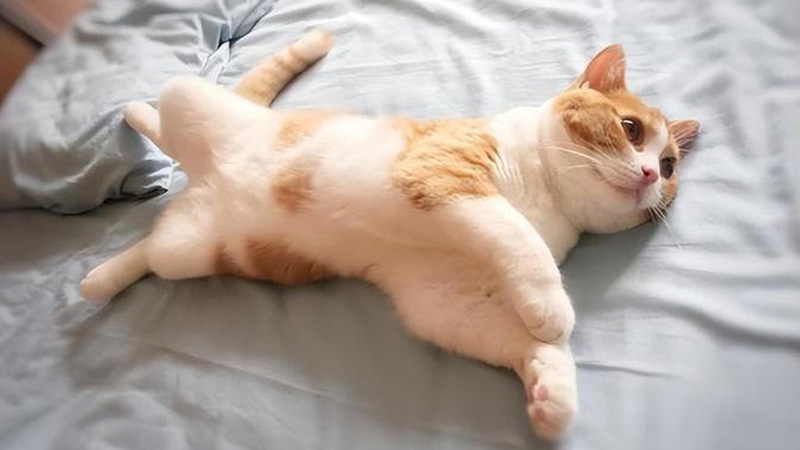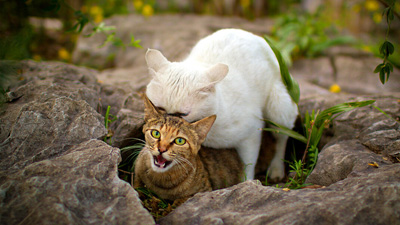Why Do Male Cats Bite Blankets and Hump?

Cats, with their playful antics and unique behaviors, often leave their owners both entertained and puzzled. One behavior that may raise eyebrows and spark curiosity is when a male cat exhibits a combination of biting and humping behavior directed toward blankets. While this behavior might seem unusual or even comical, it's essential for cat owners to delve into the underlying reasons behind such actions.
In this article, we will explore the various factors that might contribute to a male cat biting and humping blankets, shedding light on this intriguing feline behavior.
Here are some possible reasons why male cats exhibit these behaviors:
1. Residual Hormones
Even after neutering, male cats may retain residual hormones for some time. Neutering significantly reduces testosterone levels, but it takes a while for these hormones to completely leave the cat's system.
Biting and humping behaviors, particularly associated with mating instincts, can persist due to the presence of residual hormones. This behavior may gradually decrease as the hormonal influence diminishes.
2. Mating Instincts
Biting and humping are behaviors commonly associated with mating rituals in intact (non-neutered) male cats. These behaviors are part of the natural process of courtship and mating.
Neutering usually helps reduce or eliminate these behaviors, but in some cases, especially if the behavior was established before neutering, male cats may continue to display these actions.
3. Territorial Marking
Biting and humping can serve as a form of territorial marking. The act of depositing scent through biting and the physical action of humping can communicate the cat's presence and assert dominance over a particular territory.
Male cats, even after neutering, may engage in these behaviors as a way of establishing and maintaining their territory within a household.
4. Stress and Anxiety
Changes in the cat's environment or routine, as well as stressful situations, can trigger unusual behaviors, including biting and humping.
Stressors such as a new family member, moving to a new home, or the presence of unfamiliar animals can lead to stress-induced behaviors. Biting and humping may be coping mechanisms for dealing with heightened anxiety.
5. Play and Exploration
Biting blankets and humping can also be associated with play and exploration. Cats, regardless of their neutering status, may use their mouths to interact with their environment, and blankets can become targets for play.
The tactile sensation of biting and the act of humping might be satisfying for the cat in terms of play and exploration.
6. Individual Personality and Habits
Each cat has its own unique personality and habits. Some cats may develop specific behaviors as a response to their environment, experiences, or even personal preferences.
If a male cat has formed a habit of biting and humping blankets and finds it satisfying or comforting, he may continue these behaviors as part of his routine.
7. Medical Issues
In rare cases, biting and humping behaviors may be linked to medical issues. Pain or discomfort, such as from urinary tract infections or other health concerns, could influence a cat's behavior.
It's essential to rule out any potential medical issues by consulting with a veterinarian if these behaviors are sudden, severe, or accompanied by other signs of distress.
8. Lingering Habits
If a male cat developed the habit of biting and humping blankets before neutering, these behaviors may persist due to the reinforcement of established habits.
Early intervention and behavior modification strategies can be effective in gradually redirecting and minimizing these behaviors.
Strategies to Address Biting and Humping Behavior
Now that we've identified potential reasons behind a male cat's biting and humping of blankets, let's explore strategies to address and manage this behavior:
Consult with a Veterinarian:
If the biting and humping behavior is a recent development or if it causes concern, consulting with a veterinarian is a crucial first step. A thorough physical examination can help rule out any potential health issues contributing to the behavior. Additionally, your vet can provide guidance on behavior modification techniques.
Behavioral Modification Techniques:
Positive Reinforcement: Encourage alternative behaviors by using positive reinforcement. When your cat engages in appropriate behaviors or plays with designated toys instead of the blanket, reward them with treats or affection. Positive reinforcement creates positive associations, making it more likely for the cat to repeat desired behaviors.
Interactive Play: Engage your cat in interactive play sessions using toys that simulate hunting and pouncing. This can help redirect their predatory instincts in a positive and appropriate manner.
Environmental Enrichment:
Provide Scratching Posts: Cats have a natural instinct to scratch and knead surfaces. Providing scratching posts or pads can offer an outlet for this behavior and may reduce the urge to bite and hump blankets.
Offer a Variety of Toys: Enrich your cat's environment with a variety of toys that cater to different instincts. Puzzle feeders, interactive toys, and toys that encourage mental stimulation can contribute to a more fulfilling and engaged feline.
Create Safe Spaces:
Designate specific areas in your home as safe spaces for your cat. Provide cozy beds, blankets, or cat condos where they can retreat and feel secure. Creating a comfortable environment may reduce stress-induced behaviors.
Addressing Stressors:
Identify and address potential stressors in your cat's environment. If changes have occurred recently, such as a move or introduction of a new family member, take gradual steps to acclimate your cat to these changes. Providing consistency and routine can help alleviate stress.
Use Catnip or Pheromones:
Catnip and synthetic feline facial pheromones can have calming effects on some cats. Using catnip-infused toys or synthetic pheromone diffusers in the home may help create a more relaxed environment.
Provide Adequate Playtime:
Ensure your cat receives sufficient playtime and stimulation. Regular play sessions can help burn excess energy and prevent boredom, reducing the likelihood of engaging in inappropriate behaviors.
Consult with a Cat Behaviorist:
In cases where the biting and humping behavior persist despite your efforts, seeking the assistance of a certified cat behaviorist may be beneficial. A behaviorist can conduct a thorough assessment of your cat's behavior, identify triggers, and provide tailored strategies for modification.
Conclusion
Understanding why a male cat bites and humps blankets involves considering a combination of natural instincts, residual hormones, and environmental factors. By addressing potential stressors, providing appropriate outlets for instinctual behaviors, and employing positive reinforcement techniques, cat owners can effectively manage and redirect this behavior.
Patience, consistency, and a commitment to understanding their feline companion are key elements in fostering a harmonious relationship. Through a combination of proactive measures and a compassionate approach, cat owners can create an environment where their male cats feel secure, engaged, and content.
You May Also Like
 Cat BehaviorWhat is Humping Behavior in Cats?
Cat BehaviorWhat is Humping Behavior in Cats? Cat HealthIs Neutering Painful For Cats
Cat HealthIs Neutering Painful For Cats Help & AdviceHow Do I Care For My Cat After Neutering
Help & AdviceHow Do I Care For My Cat After Neutering Help & AdviceHow Do I Know if My Cat Needs to be Neutered?
Help & AdviceHow Do I Know if My Cat Needs to be Neutered? Cat HealthWhat Is The Best Age To Spay Or Neuter A Cat?
Cat HealthWhat Is The Best Age To Spay Or Neuter A Cat? Breed ReviewsThe 6 Disadvantages of Male Cats, Can You Accept Them?
Breed ReviewsThe 6 Disadvantages of Male Cats, Can You Accept Them?